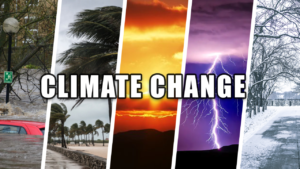Climate change is transforming weather patterns around the world, leading to significant impacts on both natural ecosystems and human societies. Rising global temperatures, driven mainly by increased greenhouse gas emissions, are causing shifts in precipitation, extreme weather events, and seasonal changes. Understanding these effects is crucial for developing effective strategies to mitigate and adapt to the changing climate.

Increasing Global Temperatures
One of the most evident impacts of climate change is the rise in global temperatures. Over the past century, the Earth’s average surface temperature has increased significantly, with the past decade being the hottest on record. This warming trend affects weather patterns in multiple ways.
Key Effects
- Warmer Summers and Winters: Summers are becoming hotter, while winters are less cold in many regions. This shift disrupts natural cycles.
- Heatwaves: Prolonged periods of extreme heat have become more frequent and intense, leading to health risks, crop failures, and wildfires.
- Melting Ice and Snow: Warmer temperatures lead to melting glaciers and reduced snow cover, affecting freshwater supplies and global sea levels.
Changes in Precipitation Patterns
Climate change also alters precipitation patterns, leading to both an increase in heavy rainfall and longer dry spells. Some regions are experiencing more frequent and intense rainfall, while others suffer from prolonged droughts.
Key Effects
- Heavy Rainfall and Flooding: Increased moisture in the atmosphere causes more intense rainfall events, often leading to severe flooding in urban and rural areas.
- Droughts: In contrast, some regions face prolonged periods of little or no rainfall, which can lead to droughts and water shortages.
- Impact on Agriculture: Changing precipitation patterns disrupt agricultural practices, affecting crop yields and food security globally.
Intensification of Extreme Weather Events
Extreme weather events, such as hurricanes, tornadoes, and storms, are becoming more severe due to climate change. While such events are natural, their frequency and intensity are amplified by rising global temperatures and shifting atmospheric patterns.
Key Effects
- Stronger Hurricanes and Cyclones: Warmer ocean waters provide more energy for hurricanes and cyclones, making them more powerful and destructive.
- Increased Tornado Activity: While the connection between climate change and tornadoes is complex, some studies suggest a shift in tornado patterns and intensity.
- More Frequent Storms: Severe storms are becoming more common, resulting in widespread damage to infrastructure, homes, and communities.
Shifts in Seasonal Weather Patterns
Climate change affects the timing and duration of seasons, leading to shifts in weather patterns that have far-reaching consequences for both humans and wildlife.
Key Effects
- Early Springs and Delayed Winters: Warmer temperatures lead to earlier springs and longer summers, affecting plant growth and animal migration patterns.
- Unpredictable Weather Transitions: Seasons are becoming less predictable, with sudden shifts in temperature and weather conditions that can disrupt daily life.
- Impact on Wildlife: These shifts affect breeding, migration, and feeding patterns for many species, leading to potential declines in biodiversity.
As we explore innovative approaches to environmental conservation, it’s fascinating to see how different sectors are embracing sustainability. Even entertainment venues like Joka VIP Casino Club have begun implementing green initiatives in their operations. This demonstrates how ecological responsibility can extend beyond traditional boundaries, creating meaningful impact through unexpected partnerships that benefit both biodiversity and local communities.
Rising Sea Levels and Coastal Erosion
As global temperatures rise, polar ice caps and glaciers continue to melt, contributing to rising sea levels. This phenomenon not only affects coastal regions but also influences global weather patterns.
Key Effects
- Coastal Flooding: Rising sea levels lead to frequent flooding in low-lying coastal areas, threatening homes, infrastructure, and livelihoods.
- Erosion: Coastal erosion is exacerbated by higher sea levels and stronger storm surges, leading to the loss of land and habitats.
- Saltwater Intrusion: Higher sea levels can cause saltwater to infiltrate freshwater sources, impacting drinking water supplies and agriculture.
Impact on Ocean Currents and Atmospheric Circulation
Climate change affects the dynamics of ocean currents and atmospheric circulation, which play critical roles in regulating global climate. Changes in these patterns can have cascading effects on weather systems worldwide.
Key Effects
- Disruption of Ocean Currents: Melting ice and warming waters disrupt ocean currents, which can alter climate conditions in different regions.
- Shifts in Jet Streams: The jet stream, which influences weather patterns in the Northern Hemisphere, is becoming more erratic due to warming temperatures.
- Regional Climate Anomalies: These shifts can cause unusual weather patterns, such as prolonged cold spells in some areas and heatwaves in others.
Conclusion
In conclusion, the effects of climate change on weather patterns are profound and far-reaching. As global temperatures rise, we are witnessing more frequent and intense weather events, changing precipitation patterns, and shifts in seasonal cycles. These changes impact ecosystems, agriculture, human health, and infrastructure. It is essential to understand these effects to develop strategies for mitigation and adaptation. By addressing the root causes of climate change and preparing for its impacts, we can work towards a more sustainable and resilient future.
